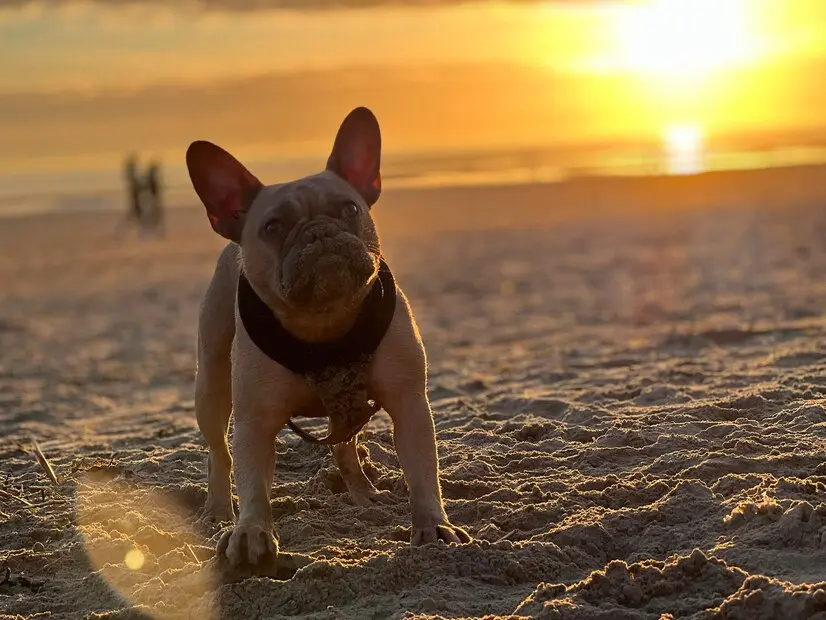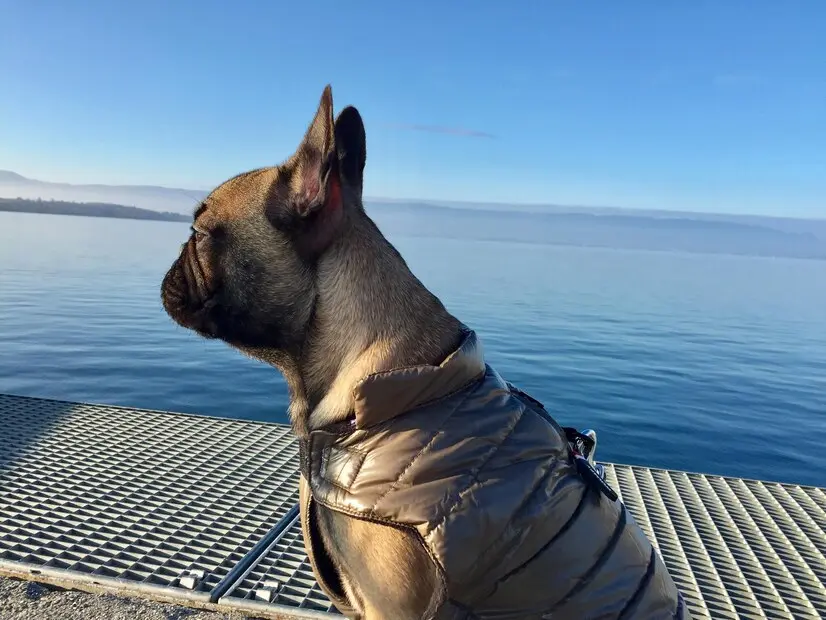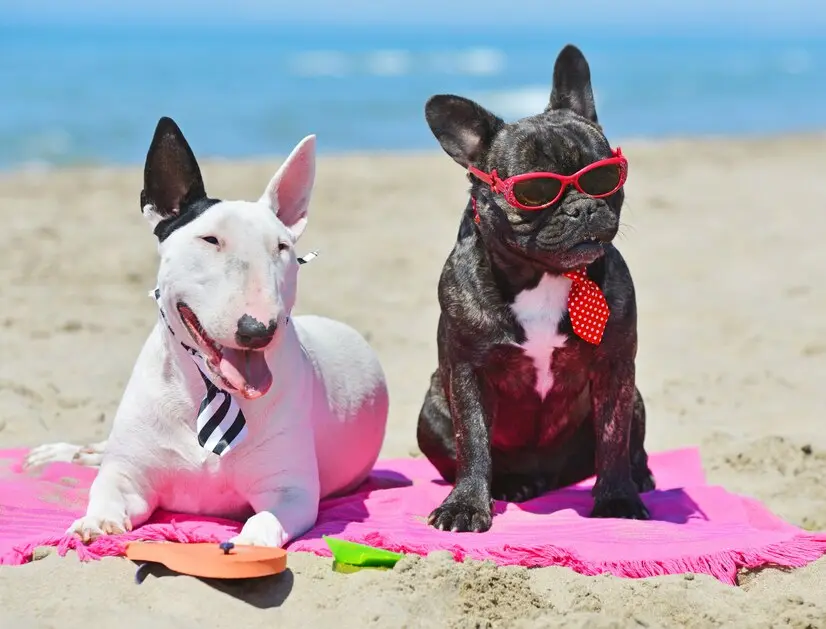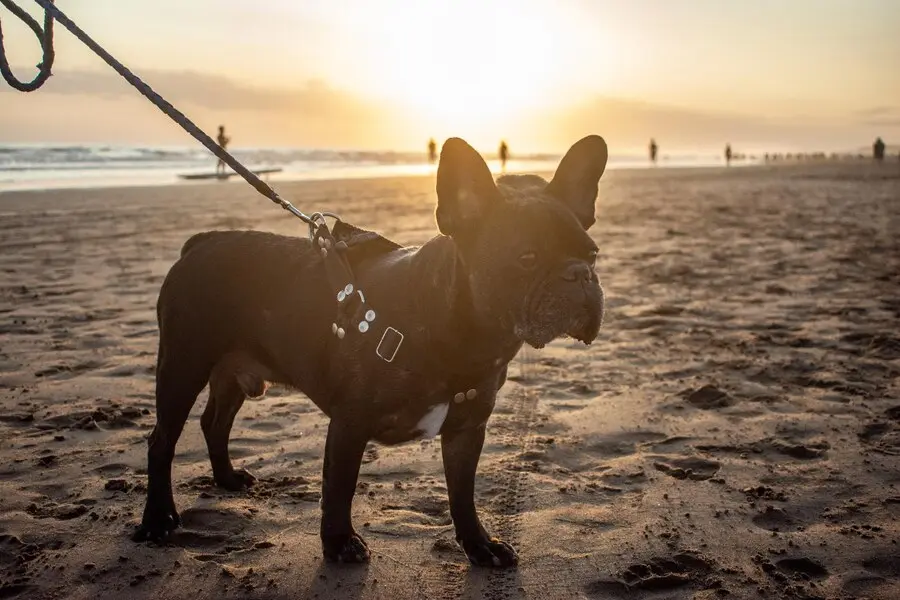Can French Bulldogs be out in the heat?

Navigating the sunny days with your French Bulldog requires a delicate balance between outdoor enjoyment and safeguarding their well-being. The question, “Can French Bulldogs be out in the heat?”
Certainly! French Bulldogs can be out in the heat, but it’s vital to take precautions. Ensure shade, hydration, and limited exposure to prevent heat-related issues.
is at the forefront of responsible pet ownership. French Bulldogs, with their distinctive charm and playful demeanor, are indeed capable of enjoying the outdoors, but their susceptibility to heat demands careful consideration.
In this comprehensive guide, we delve into the nuances of ensuring your furry companion’s safety and happiness under the sun, exploring essential tips to strike the perfect equilibrium between outdoor adventures and heat-conscious care.
I’m comfortable outside. Why is my French Bulldog so hot?

As you revel in the pleasant outdoor ambiance, your French Bulldog may not share the same comfort level, and the reason lies within the intricacies of their physiology. Despite their adorable appearance, French Bulldogs contend with unique challenges that make them more susceptible to heat.
The compact build and distinctive facial structure of Frenchies contribute to their limited ability to dissipate heat efficiently. While humans regulate temperature through sweat, these delightful companions primarily rely on panting, which is a less effective cooling mechanism.
Additionally, their dense, muscular bodies, coupled with a limited surface area compared to larger breeds, lead to quicker heat absorption and retention. The brachycephalic nature of French Bulldogs, characterized by their flat faces, further compounds the issue.
Brachycephalic breeds, including Frenchies, experience difficulty in thermoregulation due to shortened nasal passages, making it harder for them to cool down. Thus, the disparity in outdoor comfort levels arises from the unique physiological features of French Bulldogs, highlighting the need for conscientious care, especially in warmer weather, to ensure their well-being and mitigate the risks associated with heat sensitivity.
Can French Bulldogs live in hot weather?

French Bulldogs can indeed live in hot weather, but it’s essential for owners to recognize and address the challenges posed by their breed’s unique physiology. These charming companions, known for their affectionate nature and distinctive appearance, are susceptible to heat-related issues due to their short muzzles and compact build.
While they can adapt to warmer climates, responsible ownership involves taking measures to ensure their well-being. Factors such as acclimatization, individual health, and specific weather conditions play crucial roles in determining a French Bulldog’s comfort in hot weather.
Implementing preventive measures, such as providing shade, adequate hydration, and closely monitoring their activities, enables Frenchies to thrive in warm environments while minimizing the risks associated with heat exposure.
How do I know if my French Bulldog is getting too hot?

French Bulldogs, with their charming demeanor and unique physical characteristics, are particularly vulnerable to heat-related distress. Recognizing the signs is crucial for responsible pet ownership, and ensuring your Frenchie’s well-being during warm weather.
How to recognize heat distress in your French bulldog:
- Intense, swift, or excessive panting: When your French Bulldog starts panting more than usual, and it becomes intense or rapid, it’s a clear indication of heat stress. This heightened panting is their primary mechanism to cool down, and an excess of it suggests an inability to regulate their body temperature effectively.
- Elevated heart rate: Monitoring your Frenchie’s heart rate is essential. An unusually high pulse, especially when at rest, can be indicative of heat distress. This heightened heart rate is a physiological response to the body’s attempt to cool itself down.
- Excessive drooling: While some drooling is typical for French Bulldogs, an excessive amount could be a sign of heat-related discomfort. If you notice a sudden increase in drooling, it’s essential to take measures to cool your Frenchie down promptly.
- Episodes of vomiting or diarrhea: Heat stress can manifest in gastrointestinal issues. If your French Bulldog experiences episodes of vomiting or diarrhea, it’s a red flag. Dehydration and an elevated internal body temperature can contribute to these symptoms.
- Impaired coordination: Watch for any signs of unsteady movements or clumsiness. Heat distress can impact your Frenchie’s coordination, leading to stumbling or lack of balance.
- Lethargic behavior: If your normally energetic French Bulldog becomes unusually lethargic or sluggish, it may be a response to overheating. Heat stress can drain their energy, resulting in a noticeable decrease in activity.
- Mental sluggishness: Heat distress can affect cognitive function. If your Frenchie appears mentally sluggish, struggles to focus, or seems disoriented, it’s essential to address the issue promptly.
- Abnormal discoloration of the tongue or gums: Pay attention to the color of your Frenchie’s tongue and gums. Unusual shades such as brick red, blue, purple, or grey can signal inadequate oxygenation and potential heat-related complications.
- Collapsing: A severe sign of heat distress is collapsing. If your French Bulldog collapses or struggles to stay upright, immediate action is crucial. This indicates the advanced stages of heat-related issues.
- Seizures: In extreme cases, heat distress can lead to seizures. If your Frenchie experiences seizures, it’s a medical emergency, and professional veterinary intervention is required.
- Loss of consciousness: Perhaps the most critical sign, loss of consciousness, demands immediate attention. If your French Bulldog loses consciousness due to heat distress, it is an emergency situation, and you must seek veterinary assistance promptly.
What should I do if I think my French Bulldog is too hot?

When you suspect your French Bulldog is feeling the heat, swift and proactive measures are essential. Monitor for signs of distress such as intense panting, an elevated heart rate, or excessive drooling.
Move your Frenchie to a shaded area, provide access to cool water, and utilize cooling techniques like wetting their paws or using cooling mats. Limit physical activity to allow them to recover. These immediate interventions can often alleviate mild heat stress.
However, if symptoms persist or escalate, especially in severe cases like collapsing or seizures, it’s crucial to seek prompt veterinary attention to ensure your cherished companion receives the necessary care and attention.
What is heat stress vs. heat stroke?

Understanding the distinction between heat stress and heat stroke is pivotal for responsible pet care, particularly for breeds like the French Bulldog that are prone to heat-related issues.
Heat Stress
Heat stress is the initial stage where your French Bulldog struggles to regulate its body temperature. Common signs include excessive panting, elevated heart rate, and increased drooling. At this point, intervention is crucial to prevent the progression to heat stroke.
Heat Stroke
Heat stroke is a severe condition, often stemming from untreated heat stress. It manifests as a critical elevation in body temperature, leading to organ dysfunction. Symptoms include collapse, seizures, and loss of consciousness. Heat stroke requires immediate veterinary attention as it poses a significant threat to your Frenchie’s well-being.
What is the treatment for heat stroke?

- Swift Cooling Measures: The primary objective in treating heat stroke is to lower your French Bulldog’s body temperature promptly. Move them to a cooler environment, apply cool towels, and use fans to enhance air circulation. Additionally, wetting their paw pads and providing cool water can aid in the cooling process.
- Professional Veterinary Care: Seeking immediate veterinary attention is paramount. A veterinarian will employ advanced cooling techniques, administer intravenous fluids to address dehydration, and monitor for complications such as organ damage. Timely intervention significantly improves the chances of a full recovery.
- Monitoring and Aftercare: Post-treatment, continuous monitoring is essential. Your veterinarian may recommend follow-up appointments to assess your Frenchie’s recovery progress. Implementing preventive measures to avoid future heat-related incidents is crucial, involving adjustments to their environment, exercise routines, and overall care.
What are the long-term consequences of heat stroke?

- Organ Damage: One of the potential long-term consequences of heat stroke is organ damage. Elevated body temperature can strain organs, particularly the kidneys, liver, and heart. Regular veterinary check-ups can help detect and manage any lingering issues.
- Compromised Respiratory Function: Heat stroke can exacerbate respiratory issues, especially in brachycephalic breeds like the French Bulldog. Continued monitoring and, if necessary, specialized care are vital to address any respiratory complications that may arise.
- Increased Susceptibility: Once a French Bulldog has experienced heat stroke, they may become more susceptible to subsequent incidents. Owners must be diligent in implementing preventive measures, ensuring their Frenchie is not exposed to conditions that could trigger a recurrence.
What can I do for my French Bulldog to prevent heat stress and heat stroke?

Ensuring the well-being of your French Bulldog in warm weather involves proactive measures to prevent heat stress and heat stroke. These steps contribute to their comfort and safety during the hotter months.
MOnitor the weather conditions regularly
- Stay Informed: Regularly check weather forecasts, especially during the warmer seasons. Understanding temperature trends and anticipating heat waves empowers you to plan and adjust your French Bulldog’s activities accordingly.
- Heat Index Awareness: Consider the heat index, which factors in humidity along with temperature. High humidity can exacerbate heat-related issues, making it essential to be mindful of the overall heat conditions your Frenchie will experience.
Ensure there is ample shade and access to water
- Shady Retreats: Create shaded areas in your outdoor space, providing cool havens for your French Bulldog to escape the direct sun. Utilize structures, umbrellas, or natural elements to ensure there’s always a refuge from intense sunlight.
- Hydration Stations: Water accessibility is paramount. Place multiple water bowls in different locations, ensuring your Frenchie can hydrate whenever needed. Consider adding ice cubes to their water bowl for an extra cooling effect.
Supervise your dog’s activities closely
- Active Engagement: Engage with your French Bulldog during outdoor activities. By being present, you can monitor their behavior for signs of distress and intervene promptly if needed. Interactive play also allows you to control the intensity and duration of their exertion.
- Learn Their Limits: Understand your Frenchie’s individual tolerance for heat. Some may handle warmth better than others, and recognizing their limits helps tailor activities to suit their comfort levels.
Opt for indoor exercises to prevent overheating
- Indoor Alternatives: On exceptionally hot days, opt for indoor exercises. Play interactive games or provide puzzle toys to stimulate their minds without exposing them to the outdoor heat. This ensures they stay active while avoiding the risk of overheating.
- Air-conditioned Retreats: If possible, create cool indoor spaces where your French Bulldog can retreat when outdoor temperatures soar. Air-conditioned environments offer a reprieve from the heat and contribute to their overall well-being.
Restrict outdoor access during peak heat hours
- Strategic Timing: Plan outdoor activities during the cooler parts of the day, typically early mornings or late evenings. Avoid midday when temperatures peak, reducing the risk of heat-related issues for your Frenchie.
- Midday Breaks: If your French Bulldog spends time outdoors, schedule midday breaks indoors to prevent prolonged exposure to peak temperatures. This ensures they stay comfortable and safe.
Avoid exposing your dog to hot pavement surfaces
- Pavement Awareness: Be mindful of pavement temperatures during warm weather. Hot surfaces can lead to paw pad burns. Test the pavement with your hand; if it’s too hot for you, it’s too hot for your Frenchie. Opt for grassy or shaded areas for walks.
- Protective Measures: Consider protective gear like dog booties to shield your Frenchie’s paws from hot surfaces, especially when walking on asphalt or concrete.
Utilize cooling mats, coats, and bandanas for added comfort
- Cooling Accessories: Invest in cooling mats, coats, or bandanas designed for dogs. These accessories employ advanced materials that dissipate heat, providing additional comfort during warmer days. They can be particularly beneficial for outdoor activities.
- Proactive Cooling: Apply cooling products before heading outdoors, ensuring your French Bulldog starts with a lower body temperature. This proactive approach helps prevent overheating during play or exercise.
Don’t leave them in your car
- Zero Tolerance: Never leave your French Bulldog unattended in a car, even for a short duration. The temperature inside a parked car can escalate rapidly, reaching life-threatening levels within minutes. Prioritize their safety by avoiding this practice altogether.
- Safe Alternatives: If your Frenchie needs to wait while you run errands, consider pet-friendly establishments or arrange for a pet sitter. This guarantees their well-being and prevents the risk of heat-related emergencies in confined spaces.
What temperature is too hot for a French Bulldog?

Understanding the temperature thresholds for French Bulldogs is pivotal to their well-being, considering their susceptibility to heat-related issues.
Temperature Sensitivity: French Bulldogs, with their brachycephalic (short-nosed) features, are more prone to overheating. As a rule of thumb, temperatures above 80°F (27°C) can trigger discomfort. Beyond this point, their limited ability to cool down efficiently through panting puts them at an increased risk of heat stress and potential heat stroke.
Heat Index Consideration: It’s essential to factor in the heat index, accounting for humidity levels. High humidity exacerbates the challenge for French Bulldogs, as their cooling mechanism becomes less effective. A seemingly moderate temperature coupled with high humidity can pose a significant threat.
Vigilance in Warmer Months: During the warmer months, especially in climates with hot summers, it’s crucial to be particularly vigilant. Keep a watchful eye on both the ambient temperature and the apparent temperature, taking proactive measures when the mercury rises.
What breed of French Bulldog is good for warm climates?

Not all French Bulldogs are created equal when it comes to adapting to warm climates. Consider the following factors to determine which breed variations may thrive better in warmer conditions.
Coat Color Influence
Interestingly, coat color can impact a French Bulldog’s heat tolerance. Light-colored or pied (multi-colored) Frenchies tend to reflect more sunlight, helping mitigate heat absorption. Dark-colored French Bulldogs, on the other hand, absorb more heat and may find warmer climates less comfortable.
Moderate Body Mass
French Bulldogs with a moderate body mass may fare better in warm climates. Excessive weight can contribute to heat retention, whereas a leaner build aids in dissipating heat more efficiently.
Brachycephalic Considerations
While all French Bulldogs share the brachycephalic trait, some individuals within the breed may have slightly longer noses, facilitating improved airflow. This subtle variation can enhance their ability to manage heat stress more effectively.
Individual Variations
It’s essential to recognize that each French Bulldog is an individual with unique tolerances. Factors like acclimatization, health status, and personal comfort levels play crucial roles in determining how well a Frenchie adapts to warmer climates.
Consultation with Breeders
If you’re specifically seeking a French Bulldog for a warm climate, consult reputable breeders. They can provide valuable insights into the lineage, genetic factors, and individual characteristics that may influence a Frenchie’s suitability for warmer environments.
Keeping Your Frenchie Cool in Hot Weather

Helping your French Bulldog stay comfortable in warm weather involves simple yet effective measures:
Hydration Essentials:
- Provide fresh, cool water regularly.
- Use ice cubes to enhance the water bowl’s coolness.
Cooling Splash Zone:
- Consider a small pool for supervised splashing.
Chill Treat Delights:
- Prepare frozen treats with dog-friendly ingredients.
Cool Resting Spaces:
- Invest in cooling beds or mats.
- Elevate beds for enhanced airflow.
Summer Gear Investment:
- Explore cooling vests or bandanas.
- Consider protective accessories like sun hats.
On-the-Go Hydration:
- Carry a portable water bottle with an attached bowl.
- Take hydration breaks during walks.
Strategic Shade Access:
- Create shaded areas in your outdoor space.
- Bring portable shade solutions for outings.
Grooming for Heat Relief:
- Opt for a summer-appropriate haircut.
- Regularly brush to promote air circulation.
Evaporation Magic:
- Use the evaporation method with a wet towel.
- Consider dog-friendly cooling sprays or misters.
Frenchie Carrier Backpack:
- Invest in a ventilated carrier backpack for outings.
Temperature Awareness:
- Adjust outdoor activities based on temperature.
- Know signs of heat stress for prompt attention.
Implementing these practices ensures your Frenchie enjoys the warmer months with comfort and safety.
FAQs: Navigating the Heat with Your French Bulldog
Can you walk a Frenchie in heat?
Absolutely, you can walk your Frenchie during heat, but it’s essential to be mindful of the temperature. Opt for cooler times like early mornings or evenings, and ensure there’s access to shade and water. Adjust the duration and intensity of the walk based on the weather conditions to prevent overheating.
How long can a Frenchie stay in heat?
A typical heat cycle for a female Frenchie lasts around 21 days, divided into three main phases: proestrus, estrus, and diestrus. During this time, you can still engage in regular activities with your Frenchie, but it’s advisable to monitor their behavior and adjust their routine as needed.
How do you tell if a Frenchie is overheating?
Watch for signs of heat stress, including excessive panting, drooling, lethargy, or glazed eyes. If your Frenchie shows signs of distress, move them to a cooler area, offer water, and use cooling methods. Seek veterinary attention if symptoms persist.
How many days will my Frenchie bleed in heat?
The bleeding phase, or proestrus, typically lasts around 7-10 days. However, the entire heat cycle, which includes the non-bleeding phases, lasts approximately three weeks. It’s crucial to provide extra care and attention to your Frenchie during this time, addressing any behavioral or physical changes they may exhibit.
FINAL WORDS
In conclusion, while French Bulldogs can certainly enjoy outdoor activities, their well-being in the heat requires thoughtful consideration and proactive measures. Understanding the signs of heat stress, implementing preventive strategies, and being attuned to individual preferences are crucial aspects of responsible ownership.
By prioritizing hydration, providing cooling options, and monitoring environmental conditions, owners can create a safe and enjoyable outdoor experience for their French Bulldogs.
Remember, a well-cared-for Frenchie is a happy and healthy companion, capable of sharing delightful moments even in warmer weather. Always prioritize their comfort and safety to ensure a harmonious coexistence with your furry friend.




